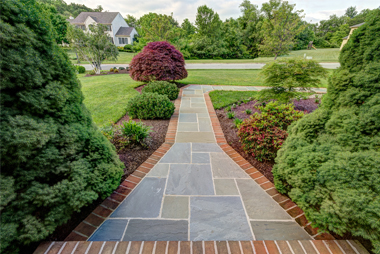If you’re looking for a way to add some extra curb appeal to your home or business, landscape curbing is a great option. Landscape curbing can be used to create borders and define different areas of your property. It’s also a low-maintenance way to keep your landscaping looking neat and tidy.
Many different types of landscape curbing are available, so you can find an option that fits your budget and your aesthetic preferences. In most cases, landscape curbing is made from concrete, but there are also options available in plastic, stone, and other materials. Customized options are also available if you want something truly unique.
This article will cover everything you should know about landscape curbing, including the different types of curbing available, the average cost, and the benefits of having landscape curbing installed.
What is Landscape Curbing?
Landscape curbing, also known as concrete edging, is a type of border that is installed around the perimeter of a property. It is usually made from concrete but can also be made from other materials like plastic, stone, or metal. Landscape curbing can be used to create different areas within a landscaped space, such as a garden bed or a lawn. It can also be used to define the borders of a driveway or walkway.
There are many different types of landscape curbing available. The most common type is poured concrete, which offers a variety of benefits, including durability and a wide range of design options. Other types of landscape curbing include precast concrete, brick pavers, stone, and plastic.
The average cost of landscape curbing varies depending on the type of material used and the size of the project. Poured concrete is typically the most expensive option, while precast concrete is usually the least expensive.
Benefits of Landscape Curbing
There are many benefits to having landscape curbing installed on your property. One of the biggest benefits is that it can help to increase your curb appeal. Landscape curbing can also be used to create different areas within your landscaping, which can be helpful if you want to define a garden bed or a lawn. Curbing can also be used to border a driveway or walkway.
Some of the additional benefits of landscape curbing include:
-Low Maintenance: Landscape curbing is a low-maintenance option for your landscaping. Once it is installed, you won’t have to worry about it cracking, chipping, or breaking.
-Durability: Landscape curbing is durable and can last many years with proper care.
-Aesthetically Pleasing: Landscape curbing can add a touch of elegance to your property. It comes in a variety of colors and styles, so you can find an option that fits your taste.
Types of Landscape Curbing
As mentioned above, there are many different types of landscape curbing available. The most common type is poured concrete, but there are also options made from precast concrete, brick pavers, stone, and plastic.
Poured Concrete
Poured concrete is the most common type of landscape curbing. It is made by pouring wet concrete into a mold that has been placed around the perimeter of your property. Once the concrete dries, it forms a solid border that can be used to create different areas within your landscaping.
Poured concrete is very durable and can last for many years with proper care. It is also low-maintenance and doesn’t require much upkeep. The only downside to poured concrete is that it can be expensive.
Precast Concrete
Precast concrete is similar to poured concrete, but the big difference is that it is made in a factory instead of on-site. Precast concrete is made by pouring wet concrete into a mold and then letting it dry. Once it is dry, the mold is removed, and the precast border is ready to be installed.
Precast concrete is less expensive than poured concrete and can be installed much faster. However, it is not as durable as poured concrete and may need to be replaced sooner.
Brick Pavers
Brick pavers are a type of landscape curbing made from individual bricks laid in a pattern. Brick pavers are very durable and can last for many years with proper care. They are also low-maintenance and don’t require much upkeep.
The only downside to brick pavers is that they can be expensive.
Stone
Stone is another type of landscape curbing that is very durable and can last for many years with proper care. Stone is also low-maintenance and doesn’t require much upkeep.
Plastic
Plastic is the least expensive type of landscape curbing, but it is also the least durable. Plastic is not as strong as other materials like concrete or stone, so it may need to be replaced sooner. Plastic is also not as aesthetically pleasing as other options.
When it comes to landscape curbing, there are many different options to choose from. The type of material you select will depend on your budget and your needs. If you are looking for a low-maintenance option that is durable and aesthetically-pleasing, then concrete or stone may be the best choice for you. If you are on a tight budget, then plastic may be the best option.
No matter what type of landscape curbing you choose, it will add value to your property and help increase your curb appeal. Don’t forget to take into account the costs of installation when you are budgeting for your project. Landscape curbing is an investment that will pay off in the long run!






